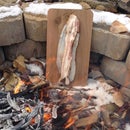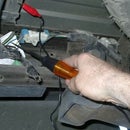Introduction: How to Cover a Pot Pie Crust for Perfect Baking
Instructions for baking a pot pie usually recommend covering the edge of the crust with cooking foil. This sounds easy, but the normal method of tearing off a strip and trying to wrap it around a round pie does not work well.
Even a small pot pie will require at least two strips, and the flat strips do not bend around the circumference of a circular shape.
Here are the instructions for how to do it better. This technique will take only a little more time than the rough-and-ready method, and the results are perfect!
Here is my pot pie, wrapped with foil and ready for baking:
Even a small pot pie will require at least two strips, and the flat strips do not bend around the circumference of a circular shape.
Here are the instructions for how to do it better. This technique will take only a little more time than the rough-and-ready method, and the results are perfect!
Here is my pot pie, wrapped with foil and ready for baking:
Step 1: Read the Directions
Directions for baking a pot pie usually recommend that you wrap the crust edge with a strip of aluminum foil. I will show you a good method of doing this.
Wrapping the crust edge is recommended for all kinds of pies: fruit pies and meat pies, frozen and fresh, homemade and store-bought.
Without wrapping the crust, the edges will likely burn if you try to bake the pie until the center crust is browned. The crust edge is thinner and easily burns. If you shorten the recommended time for baking, the crust edge may brown just fine, but the center crust will be underdone.
This issue is even more important for meat pies. Meat must reach a certain internal temperature to ensure that it is fully cooked...any thing less increases the chance of ingesting parasites or harmful bacteria. To reach the recommended internal temperature requires baking the full amount of time at the proper oven temperature. This will likely burn the crust edges unless you cover them with foil.
Wrapping the crust edge is recommended for all kinds of pies: fruit pies and meat pies, frozen and fresh, homemade and store-bought.
Without wrapping the crust, the edges will likely burn if you try to bake the pie until the center crust is browned. The crust edge is thinner and easily burns. If you shorten the recommended time for baking, the crust edge may brown just fine, but the center crust will be underdone.
This issue is even more important for meat pies. Meat must reach a certain internal temperature to ensure that it is fully cooked...any thing less increases the chance of ingesting parasites or harmful bacteria. To reach the recommended internal temperature requires baking the full amount of time at the proper oven temperature. This will likely burn the crust edges unless you cover them with foil.
Step 2: Assemble Your Supplies
You will need:
- aluminum cooking foil
- scissors or cooking shears
- pot pie (any flavor, any size, fresh or frozen, homemade or store-bought)
- about five minutes of time.
- aluminum cooking foil
- scissors or cooking shears
- pot pie (any flavor, any size, fresh or frozen, homemade or store-bought)
- about five minutes of time.
Step 3: Tear Off a Piece of Foil
Tear off a square of foil, about one-inch larger than the diameter of your pie. This six-inch pie required a square of foil about seven inches square.
Step 4: First Fold
Fold the top right corner diagonally down to align with the bottom edge. This will roughly form a triangular shape.
Step 5: Second Fold
Fold the bottom right corner up to align with the top edge of the triange, forming a doubled triangular shape, with a point at the right side.
Step 6: First Cut
Place the pointed tip of the folded triangle at the center of the pie to estimate where to cut the foil. The goal is to cut the tip off, following the round shape of the pie, about one inch larger than the diameter of the pie.
I've drawn a line to help visualize where to cut, but you certainly don't have to do the same...it should be easy to cut without drawing a line.
I've drawn a line to help visualize where to cut, but you certainly don't have to do the same...it should be easy to cut without drawing a line.
Step 7: Second Cut
Now we need to cut out the inside of our foil cover.
Again, place the pointed tip of the folded cover at the center of the pie and estimate a line to cut on the inside, about one inch smaller than the diameter of the pie.
The goal is to create an opening that will expose all of the crust EXCEPT the thin edge crust.
I drew a line to better display the intention of this step. You do not have to actually draw a line if you can visualize a line to follow as you cut.
Again, place the pointed tip of the folded cover at the center of the pie and estimate a line to cut on the inside, about one inch smaller than the diameter of the pie.
The goal is to create an opening that will expose all of the crust EXCEPT the thin edge crust.
I drew a line to better display the intention of this step. You do not have to actually draw a line if you can visualize a line to follow as you cut.
Step 8: Unfold the Foil Cover
Unfold the foil cover and center over the top of the pie. There should be an overhanging margin of foil about one inch larger than the diameter of the pie.
Step 9: Wrap the Edge Crust
Carefully wrap the overhanging margin of foil around and under the edge of the crust. Keep the cover centered over the pie as you wrap.
Step 10: Prepare to Bake
Place your foil-covered pies on a baking sheet and place into an oven, pre-heated to the correct temperature as specified by your cooking directions or recipe.
Allow the pies to bake for the recommended time.
Allow the pies to bake for the recommended time.
Step 11: Take Your Pies Out of the Oven
When the recommended cooking time expires, remove the pies from the oven using protective kitchen mitts or hotpads. Set the pies on a heat-proof surface!
The crust should look lightly browned. It should have a firm feel and a flakey appearance if poked by a fork.
My pie looks great so far...lightly brown, just starting to crack...looks delicious!
But...what about the edge crust? Is it burnt? Is it undercooked? Calm my beating heart and relieve my fears!
The crust should look lightly browned. It should have a firm feel and a flakey appearance if poked by a fork.
My pie looks great so far...lightly brown, just starting to crack...looks delicious!
But...what about the edge crust? Is it burnt? Is it undercooked? Calm my beating heart and relieve my fears!
Step 12: Success!
Remove the cover and check the crust. It should be lightly browned and flakey.
My pie looks perfect! The foil has protected crust from burning, allowing the center crust to brown and the inside of the pie to reach the recommended internal cooking temperature.
Now, to prepare my dish and enjoy my dinner!
My pie looks perfect! The foil has protected crust from burning, allowing the center crust to brown and the inside of the pie to reach the recommended internal cooking temperature.
Now, to prepare my dish and enjoy my dinner!
Step 13: Serve Your Pot Pie
Here you can see a close-up of the flakey crust and steaming goodness inside.
Step 14: Favorite Combination: Pot Pie and Cottage Cheese
This is my favorite combination when serving a pot pie. The light, fresh, cold taste of cottage cheese contrasts nicely with the heavier, meaty savor of the pot pie. A forkful of pie, topped with cottage cheese...ah, que buena! Me gusta mucho!











